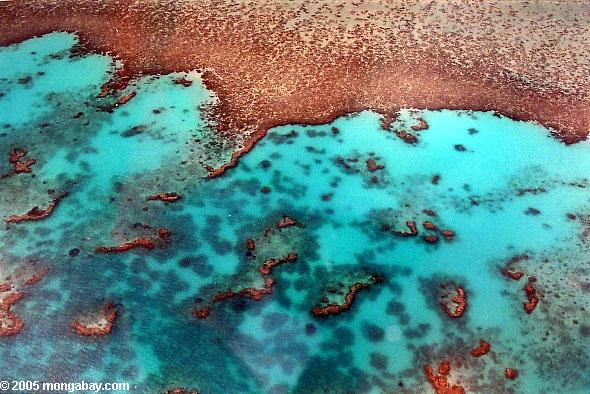Four unarmed bombs dropped by the US military into the Great Barrier Reef Marine Park pose a low risk to wildlife and a joint mission will aim for their “rapid recovery”, according to the government agency in charge of the reef.
The Great Barrier Reef Marine Park Authority said two of the bombs are inert, containing concrete, while the other two were not armed, making the chance of detonation “extremely low”.
The bombs were dropped during a training drill prior to Talisman Saber, a joint US and Australian exercise that takes place every two years in northern Queensland.
The incident occurred last Tuesday after two US navy Harrier jets ran dangerously low on fuel and dropped their payloads into the water, around 30km from the nearest reef. The aircraft were meant to be undertaking a bombing exercise on Townshend Island, which lies north east of Rockhampton.
The US navy said it was working with Australian authorities to investigate the incident.
Greens senator Larissa Waters told Guardian Australia that the botched exercise raised concerning questions about “war games” on the Great Barrier Reef.
“The Great Barrier Reef is already under huge pressure from mining, and now, it seems from US bombs,” she said. “It beggars belief really, I thought at first that this was a joke.

Aerial view of the Great Barrier Reef, Australia. Photo by: Rhett A. Butler.
“This training area is exempt from protections for the reef which is worrying when there is such huge weaponry and munitions involved. It’s simply not an appropriate place for war games and I will be raising the matter in Senate estimates. This is a huge safety issue, it’s outrageous there wasn’t better safety with the boats involved, especially given that this area is a tourist Mecca.”
A spokesperson for the Great Barrier Reef Marine Park Authority said: “The incident was deemed by the authority to be low risk to the marine environment and has been addressed as an operational matter since it occurred.
“A high priority for the authority is to continue to work with the Department of Defence to identify options for rapid recovery of the ordnances so they pose no risk to the marine park and stakeholders.”
US 7th Fleet Commander William Marks told the ABC that the planes aborted the scheduled mission as there were civilian boats in the training area.
“I don’t have any more information about what [the boats] were doing or why they were there, but part of our procedures is to do that safety check and if we do see that, then we, for safety reasons, do not drop any ordnance,” he said.
“The Harriers had a relatively low [fuel] state, and needed to get back to the ship, and so they conducted an emergency jettison.
“Their priority was to get to a place which would take the least impact. We believe we did drop in between 50 and 60 metres of water in a place where it is not a hazard to shipping and not a hazard to navigation.”
Original Post: US bombs dropped on Great Barrier Reef ‘pose low risk to wildlife’
Related articles
UN may downgrade Great Barrier Reef’s heritage status due to Australia’s inaction on threats
(06/17/2013) The federal government insists it is striving to avoid the Great Barrier Reef being listed ‘in danger’ ahead of a crunch UN meeting, after rejecting a Senate recommendation to block new port developments near the World Heritage ecosystem.
Great Barrier Reef loses half its coral in less than 30 years

(10/01/2012) The Great Barrier Reef has lost half of its coral cover in the last 27 years, according to a new study released today in the Proceedings of the National Academy of Sciences (PNAS). Based on over 2,000 surveys from 1985 to this year the study links the alarming loss to three impacts: tropical cyclone damage, outbreaks crown-of-thorns starfish that devour corals, and coral bleaching.
Australia sets aside 40 percent of its waters for protection

(06/14/2012) In an announcement to coincide with the beginnings of the UN’s Rio+20 Summit on Sustainable Development, Australia has announced ambitious plans to protect 3.1 million square kilometers (1.19 million square miles) of its ocean, including the Coral Sea. If enacted, the proposition will increase Australia’s marine protected areas from 27 to 60, covering about 40 percent of Australia’s waters.